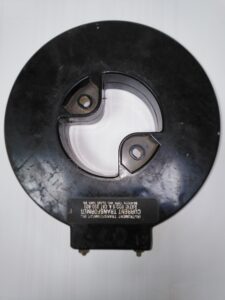A current transformer is a type of instrument transformer that transforms alternating current (AC) from high to low value.
This current is proportional to the current measured in primary windings. These types of transformers are used for safety measures.
The primary winding of the current transformer consists of a limited number of turns. While the secondary winding consists of a large number of turns.
There are three different current transformer types in use. Let’s discuss this in detail.
Table of Contents
Applications and usage
Current transformers (CTs) have a wide range of applications in electrical power systems and are crucial for various functions. Some of the key applications and uses of CTs include:
-
Metering and Billing: Current transformers are used for metering and billing purposes in electricity distribution systems. They accurately measure the current flowing through power lines and help in determining the electricity consumption of individual consumers.
-
Protective Relaying: CTs are an essential component of protective relaying systems. They provide input to protective relays, which detect abnormal conditions such as overcurrent, undercurrent, and short circuits. This helps in isolating faulty sections of the system and preventing damage to equipment.
-
Power Quality Monitoring: CTs are used in power quality monitoring systems to measure parameters such as harmonics, voltage fluctuations, and power factor. This information is crucial for maintaining a stable and efficient power supply and ensuring compliance with regulatory standards.
-
Control and Instrumentation: CTs are utilized in control and instrumentation systems to provide input for various control devices, such as meters, controllers, and data acquisition systems. They help in monitoring and regulating the flow of electricity through different sections of the power system.
-
Energy Management Systems: Current transformers play a vital role in energy management systems by providing data for load profiling, energy audits, and demand-side management. They assist in optimizing energy usage and improving the overall efficiency of the power distribution network.
-
Fault Detection and Diagnosis: CTs are used to detect and diagnose faults in electrical systems, including ground faults, phase imbalances, and insulation failures. This helps in maintaining the reliability and safety of the electrical infrastructure.
-
Renewable Energy Systems: CTs are employed in renewable energy systems, such as solar and wind power plants, to monitor the flow of current from the generation source to the grid. They assist in ensuring the seamless integration of renewable energy into the existing power grid.
-
Transformer and Equipment Protection: CTs are utilized for protecting transformers and other electrical equipment from overcurrent and short-circuit conditions. They provide input to protective devices that help in preventing damage to expensive and critical equipment.
Overall, CTs are essential devices that facilitate the safe, efficient, and reliable operation of electrical power systems, making them indispensable in various industrial, commercial, and residential applications.
types of current transformer

Current transformers (CTs) are categorized based on their construction, purpose, and usage. Here are some common types of current transformers:
-
Wound Type Current Transformer: This is the most common type of CT. It consists of a primary winding and a secondary winding. The primary winding carries the current to be measured, and the secondary winding is connected to the measuring instrument or protective device.
-
Bar Type Current Transformer: In this type, the primary conductor itself acts as the primary winding of the transformer. Bar CTs are often used in high-current applications, such as in high-voltage power transmission systems.
-
Window (or Ring) Type Current Transformer: These CTs have a window or ring-shaped core, and the primary conductor is passed through the window. They are commonly used in applications where it’s difficult to interrupt the primary circuit, as they can be installed without breaking the primary circuit.
-
Wound Primary (or Bushing) Current Transformer: This type of CT has a primary winding that is directly connected to the primary circuit, while the secondary winding is connected to the measuring instrument. Bushing CTs are commonly used in high-voltage applications, such as transformers and circuit breakers.
-
Summation Current Transformer: These CTs are used to measure the total current in multiple conductors, providing a summed output of the currents passing through each conductor.
-
Protection Current Transformer: These CTs are designed specifically for protective relaying purposes, providing accurate measurements for protective devices to operate effectively during faults and abnormal conditions.
-
High-Frequency Current Transformer: These specialized CTs are used in applications where high-frequency currents need to be measured accurately, such as in power electronics and high-frequency equipment.
Each type of current transformer is designed to meet specific requirements in various applications, ensuring accurate measurement, reliable performance, and efficient operation of the electrical systems they are employed in.
What is a neutral current transformer and where do we use it?
A neutral current transformer, often abbreviated as CT, is a type of current transformer that is used to measure or monitor the current flowing through the neutral conductor of a three-phase electrical system.
It is primarily employed in power distribution systems and electrical networks to provide data on the neutral current, which can be crucial for various purposes such as protective relaying, metering, and power quality monitoring.
Some key points regarding neutral current transformers:
-
Measurement of Neutral Current: It allows the monitoring and measurement of the current flowing in the neutral conductor. This is important because an imbalance in the neutral current can indicate issues such as unbalanced loads or the presence of harmonics in the system.
-
Protection: Neutral current transformers are often used in protective relaying schemes, where they play a role in detecting ground faults or imbalances in the system that could lead to potentially hazardous conditions. They are crucial components in ensuring the safety and stability of the electrical system.
-
Metering: They can also be used in metering applications to accurately measure the power consumption and analyze the power quality of the system.
-
Power Quality Monitoring: Monitoring neutral current can provide valuable insights into the power quality of the system, helping to identify problems such as voltage fluctuations, harmonic distortions, and other issues that can affect the performance of electrical equipment.
Neutral current transformers are designed to be highly accurate and reliable in measuring the neutral current, ensuring that the electrical system operates within safe parameters and that any issues are detected promptly.
They are an integral part of the broader network of protective and monitoring devices used in electrical systems to maintain efficient and safe operations.
Install my Free Android App on Google Play:
Electrical Cables Most Common Tables
And, my Electrical Calculations App “”
Discover more great content by subscribing to My channel
Looking to stay ahead of the game in the world of electrical engineering? Subscribe to my YouTube channel and gain access to exclusive content you won’t find anywhere else!
The staff I recommend
(Amazon Affiliate Links to products I believe are high quality):
- Economy 120 Volt/60Hz AC Power Source – Step-Down Voltage & Frequency Converters 1800W
- UNI-T Digital Multimeter Tester UT139C
- 50-Amp Extension Cord for RV “100ft”
- Voltage Stabilizer 110/220v
- Hair Dryer “best selling“
- TOSHIBA EM131A5C-BS Countertop Microwave Ovens
Disclaimer: This contains affiliate links to Amazon products. I may earn a commission for purchases made through these links.




